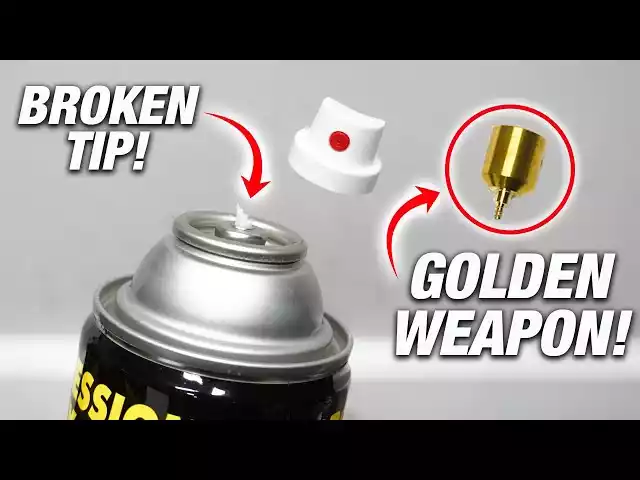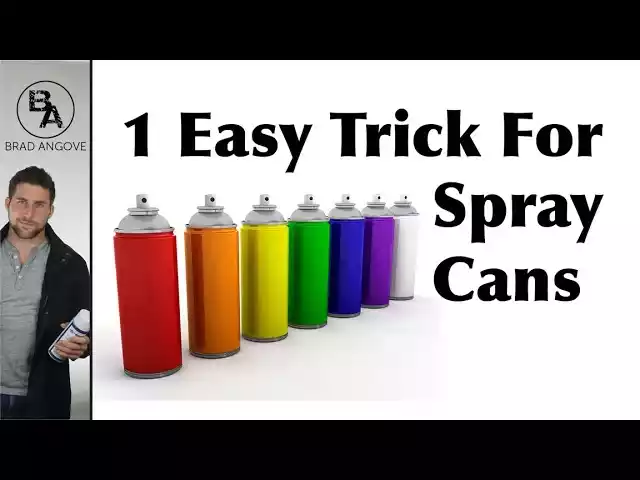Spray cans are a staple in many DIY projects, offering a quick and efficient way to apply paint, varnish, or other coatings. They are incredibly convenient, but they can also be frustrating when things go wrong. From clogged nozzles to uneven spray patterns, these issues can derail your project and waste your time and money. Understanding these common problems and knowing how to fix them can make your spray can experience much smoother.
Spray cans work on a simple principle: they use a propellant to push the paint out of the can through a nozzle, creating a fine mist. This allows for even coverage and a smooth finish. However, several factors can interfere with this process, leading to common issues like clogs, leaks, and uneven sprays. Knowing how to troubleshoot these problems can save you a lot of headaches.
In this comprehensive guide, we’ll explore the mechanics of spray cans, identify common issues, and provide detailed solutions to fix them. Whether you’re a seasoned DIYer or a beginner, this guide will equip you with the knowledge you need to tackle any spray can problem.
Understanding Spray Can Mechanics
How Spray Cans Work
Spray cans are designed to deliver a fine mist of paint or other substances through a pressurized system. The canister contains a mixture of the product and a propellant, usually a liquefied gas. When the nozzle is pressed, the propellant forces the product out of the can in a controlled spray.
Components of a Spray Can
• Canister: Holds the paint and propellant.
• Valve: Controls the release of the contents.
• Dip Tube: Extends from the valve to the bottom of the can, allowing the product to be drawn up.
• Nozzle: Directs the spray and determines the spray pattern.
Common Issues with Spray Cans
Clogged Nozzles
Clogged nozzles are one of the most frequent problems encountered with spray cans. This issue can occur due to dried paint or debris blocking the nozzle, preventing the spray from being released properly.
Uneven Spray Patterns
Uneven spray patterns can result in blotchy or streaky finishes. This problem is often caused by improper spraying techniques or issues with the nozzle.
Low Pressure
Low pressure in a spray can can lead to weak or inconsistent spray. This issue can be due to a variety of factors, including a depleted propellant or a malfunctioning valve.
Leaking Cans
Leaking cans can be messy and wasteful. Leaks can occur due to damage to the canister or a faulty valve.
Paint Drips and Runs
Paint drips and runs can ruin the finish of your project. This issue is often caused by applying too much paint at once or holding the can too close to the surface.
Fixing Clogged Nozzles

Identifying a Clogged Nozzle
A clogged nozzle can be identified by a weak or non-existent spray. If the spray is sputtering or coming out in a thin stream, the nozzle is likely clogged.
Cleaning Techniques
• Soaking in Solvent: Remove the nozzle and soak it in a solvent such as acetone or mineral spirits to dissolve the clog.
• Using a Pin: Carefully insert a pin or needle into the nozzle to clear any blockages.
• Blowing Air: Use compressed air to blow out any debris from the nozzle.
Preventative Measures
• Regular Cleaning: Clean the nozzle after each use to prevent clogs.
• Proper Storage: Store spray cans with the nozzle facing up to prevent paint from settling in the nozzle.
Addressing Uneven Spray Patterns
Causes of Uneven Spray
Uneven spray patterns can be caused by a variety of factors, including a clogged nozzle, improper spraying technique, or low pressure.
Solutions for Even Application
• Proper Technique: Hold the can at the recommended distance from the surface and use smooth, even strokes.
• Check Nozzle: Ensure the nozzle is clean and free of debris.
• Shake Well: Shake the can thoroughly before use to ensure the paint and propellant are properly mixed.
Maintenance Tips
• Regular Inspection: Inspect the nozzle and valve regularly for any signs of wear or damage.
• Test Spray: Perform a test spray on a piece of cardboard or scrap material before starting your project.
Resolving Low Pressure Problems

Diagnosing Low Pressure
Low pressure can be identified by a weak or inconsistent spray. If the spray is sputtering or coming out in a thin stream, the can may be experiencing low pressure.
Steps to Increase Pressure
• Shake Well: Shake the can thoroughly to ensure the paint and propellant are properly mixed.
• Warm the Can: Place the can in warm water for a few minutes to increase the pressure.
• Check Valve: Ensure the valve is functioning properly and not obstructed.
Long-term Solutions
• Proper Storage: Store spray cans in a cool, dry place to prevent pressure loss.
• Regular Use: Use spray cans regularly to prevent the propellant from settling.
Handling Leaking Cans
Detecting Leaks
Leaks can be detected by a hissing sound or visible paint seeping from the can. If you notice any signs of a leak, it’s important to address it immediately.
Temporary Fixes
• Seal with Tape: Use duct tape or electrical tape to temporarily seal the leak.
• Transfer Contents: Transfer the contents to another container if possible.
Permanent Solutions
• Replace Can: If the can is damaged beyond repair, replace it with a new one.
• Repair Valve: If the leak is coming from the valve, it may be possible to repair or replace the valve.
Preventing Paint Drips and Runs
Proper Spray Techniques
• Hold the Can at the Right Distance: Hold the can at the recommended distance from the surface to prevent drips and runs.
• Use Smooth, Even Strokes: Apply the paint in smooth, even strokes to ensure an even coat.
• Apply Thin Coats: Apply multiple thin coats rather than one thick coat to prevent drips and runs.
Environmental Factors
• Temperature and Humidity: Avoid spraying in extreme temperatures or high humidity, as this can affect the paint’s consistency and drying time.
• Wind: Avoid spraying in windy conditions, as this can cause the paint to drift and create an uneven finish.
Correcting Mistakes
• Wipe Away Drips: If you notice a drip or run, wipe it away immediately with a clean cloth.
• Sand and Repaint: If the paint has already dried, sand the area smooth and apply a new coat of paint.
Choosing the Right Spray Can for Your Project
Types of Spray Cans
• Aerosol Paint: Ideal for general-purpose painting and touch-ups.
• Spray Primer: Used to prepare surfaces for painting.
• Specialty Sprays: Includes options like metallic, high-heat, and textured sprays.
Selecting Based on Material
• Metal: Choose a spray paint designed for metal surfaces.
• Wood: Use a spray paint that is suitable for wood.
• Plastic: Select a spray paint that adheres well to plastic.
Cost vs. Quality
• Budget Options: Affordable spray paints are suitable for small projects and touch-ups.
• Premium Options: Higher-quality spray paints offer better coverage and durability.
Safety Precautions When Using Spray Cans
Protective Gear
• Gloves: Wear gloves to protect your hands from paint and chemicals.
• Mask: Use a mask to avoid inhaling fumes.
• Goggles: Wear goggles to protect your eyes from overspray.
Ventilation
• Work in a Well-Ventilated Area: Ensure proper ventilation to avoid inhaling fumes.
• Use Fans: Use fans to improve air circulation.
Safe Disposal
• Empty Cans: Dispose of empty cans according to local regulations.
• Hazardous Waste: Treat partially full cans as hazardous waste and dispose of them accordingly.
Environmental Impact of Spray Cans
Eco-friendly Alternatives
• Low-VOC Sprays: Choose spray paints with low volatile organic compounds (VOCs) to reduce environmental impact.
• Water-based Sprays: Opt for water-based spray paints as a more environmentally friendly option.
Recycling Tips
• Recycle Empty Cans: Check with your local recycling program to see if they accept empty spray cans.
• Proper Disposal: Follow local regulations for disposing of spray cans.
Reducing Waste
• Use What You Need: Only purchase the amount of spray paint you need for your project.
• Store Properly: Store spray cans properly to extend their shelf life and reduce waste.
Professional Tips for Optimal Spray Can Use
Expert Advice
• Test Spray: Always perform a test spray on a piece of cardboard or scrap material before starting your project.
• Shake Well: Shake the can thoroughly before use to ensure the paint and propellant are properly mixed.
Common Mistakes to Avoid
• Holding the Can Too Close: Holding the can too close to the surface can result in drips and runs.
• Not Shaking the Can: Failing to shake the can properly can result in uneven spray.
Advanced Techniques
• Layering: Apply multiple thin coats for a smooth, even finish.
• Blending: Use blending techniques to create smooth transitions between colors.
DIY Projects Using Spray Cans
Home Improvement Ideas
• Furniture Makeover: Use spray paint to give old furniture a new look.
• Cabinet Refresh: Update kitchen cabinets with a fresh coat of spray paint.
• Outdoor Furniture: Revitalize outdoor furniture with weather-resistant spray paint.
Craft Projects
• Decorative Items: Create custom decorative items with spray paint.
• Picture Frames: Give old picture frames a new look with a coat of spray paint.
• Holiday Decorations: Use spray paint to create unique holiday decorations.
Outdoor Applications
• Garden Decor: Use spray paint to add color to garden decor.
• Patio Furniture: Refresh patio furniture with a new coat of spray paint.
• Outdoor Art: Create outdoor art pieces with spray paint.
FAQs
How to Unclog a Spray Can Nozzle?
Clogged nozzles are a common issue with spray cans. To unclog a nozzle, start by removing it from the can and soaking it in a solvent such as acetone or mineral spirits. This will help dissolve any dried paint or debris blocking the nozzle. If soaking doesn’t work, use a pin or needle to carefully clear the blockage. Another method is to blow compressed air through the nozzle to dislodge any debris. To prevent future clogs, clean the nozzle after each use and store the can with the nozzle facing up.
What Causes Uneven Spray Patterns?
Uneven spray patterns can be caused by several factors, including a clogged nozzle, improper spraying technique, or low pressure. To achieve an even spray, ensure the nozzle is clean and free of debris. Hold the can at the recommended distance from the surface and use smooth, even strokes. Shake the can thoroughly before use to ensure the paint and propellant are properly mixed. Performing a test spray on a piece of cardboard or scrap material can also help identify any issues before starting your project.
How to Fix Low Pressure in a Spray Can?
Low pressure in a spray can can result in weak or inconsistent spray. To fix this issue, start by shaking the can thoroughly to ensure the paint and propellant are properly mixed. If the pressure is still low, try warming the can by placing it in warm water for a few minutes. This can help increase the pressure. Check the valve to ensure it is functioning properly and not obstructed. If the can is old or has been stored improperly, it may be best to replace it with a new one.
What to Do if a Spray Can is Leaking?
Leaking spray cans can be messy and wasteful. If you detect a leak, start by identifying the source. If the leak is coming from the valve, it may be possible to repair or replace the valve. For temporary fixes, use duct tape or electrical tape to seal the leak. If the can is damaged beyond repair, transfer the contents to another container if possible. Always handle leaking cans with care and dispose of them according to local regulations.
How to Prevent Paint Drips and Runs?
Preventing paint drips and runs involves using proper spray techniques and being mindful of environmental factors. Hold the can at the recommended distance from the surface and use smooth, even strokes. Apply multiple thin coats rather than one thick coat to prevent drips and runs. Avoid spraying in extreme temperatures or high humidity, as this can affect the paint’s consistency and drying time. If you notice a drip or run, wipe it away immediately with a clean cloth. For dried drips, sand the area smooth and apply a new coat of paint.
Relevant Data Table
Common Issues and Solutions
| Issue | Cause | Solution |
|---|---|---|
| Clogged Nozzle | Dried paint or debris | Soak in solvent, use a pin, blow air |
| Uneven Spray | Improper technique, clogged nozzle | Proper technique, clean nozzle, shake well |
| Low Pressure | Depleted propellant, malfunctioning valve | Shake well, warm can, check valve |
| Leaking Can | Damaged canister, faulty valve | Seal with tape, transfer contents, replace can |
| Paint Drips | Too much paint, holding can too close | Proper technique, apply thin coats, correct mistakes |
Types of Spray Cans
| Type | Best For | Examples |
|---|---|---|
| Aerosol Paint | General-purpose painting | Rust-Oleum, Krylon |
| Spray Primer | Preparing surfaces | Zinsser, Kilz |
| Specialty Sprays | Metallic, high-heat, textured finishes | Rust-Oleum Metallic, VHT High Heat |
Conclusion
Spray cans are a versatile and convenient tool for a wide range of projects, but they come with their own set of challenges. By understanding common issues such as clogged nozzles, uneven spray patterns, low pressure, leaking cans, and paint drips, you can take the necessary steps to fix them and achieve a professional finish. Remember to follow safety precautions, choose the right spray can for your project, and use proper techniques to ensure the best results. With the right knowledge and skills, you can tackle any spray can issue with confidence and create beautiful, lasting finishes.
HOW TO MAKE THE BEST OF YOUR 20’s // important things I …
Ruth Aquilani is a renowned graffiti artist known for her bold, colorful, and expressive style. She began her career as a street artist in the early 2000s, quickly making a name for herself in the graffiti community with her unique and striking works of art.
